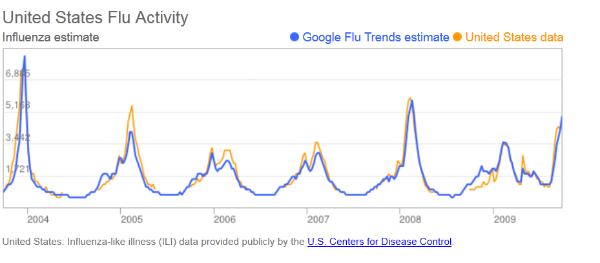Big Data Touches Us All

In this series of articles, I have often spoken about ‘big data’ and how it is revolutionizing many aspects of our life. There are ethical issues with the management of big data and I discussed this in an earlier post. But let me relate another story.
Back in 2009 much of the world was reeling under the impact of the H1N1 virus. This particular outbreak was so violent and the spread was so fast that it was already being compared to the Spanish Flu outbreak of 1918. The 1918 episode had infected nearly half a billion people and was responsible for the death of millions. The H1N1 outbreak was thought to be similar.
To be able to control H1N1, governments first had to know the regions which were the worst affected. Even in today’s world with the best electronic communications, there was a problem. Typically when people were first infected, they suffered from body ache, a mild fever, a headache and related symptoms. These symptoms could occur due to a hundred different reasons – including a hangover. Many would take an aspirin and hope they would be better the next day. Only after a couple of days would they consult a doctor – once again a correct diagnosis – even with a qualified doctor – would take some time. In fact, the detection of H1N1 cases was lagging behind infection by nearly a week.
Information about a positive test for H1N1 in the US was to be sent to the Center for Disease Control and Prevention (CDC) where a regional map was created and teams and resources were moved to the areas worst affected. However, as the discussion so far shows, there was an inherent delay of one to two weeks in updating charts.
The battle against H1N1 was being lost in spite of the most modern tools and medicines.
A few months prior to the outbreak, engineers had written a scientific paper that had discussed a scenario very similar to the H1N1 outbreak. Researchers had shown that they could predict the occurrence of the common flu in an area merely by analyzing Internet search patterns. Using a very large number of search records (typical big data) and correlating with the actual progress of the H1N1 virus, they were able to determine that if a region was seeing a high prevalence of 45 specific keyword searches (possibly terms like body ache, fever, sneezing, headache, etc), then there was a serious possibility that H1N1 was active in that area. This was before the disease/virus was detected medically.
The ability to analyze big data is possessed by cloud technology where a reliable infrastructure needs to be in place [1].
Using this analysis, researchers were able to finally get medical teams to sites that were affected by H1N1 before doctors had begun to detect the virus. And that is how the tide was turned in the fight against the virus.

This is not just a story. It really happened. And since the public was involved and the information was not classified, we know of the situation and how it was controlled. I am sure that there are thousands of other such stories as well – possibly not so well known – where big data is making a huge impact on our lives and we are simply not aware of it. I am not talking about how Wal-Mart is improving efficiencies or how Target is finding out if you are pregnant (apologies to male readers).
Such collection and analysis of big data would not have been possible without cloud computing. High quality, established cloud data centers have a big role to play in efforts like this one.
Be Part of Our Cloud Conversation
Our articles are written to provide you with tools and information to meet your IT and cloud solution needs. Join us on Facebook and Twitter.
About the Guest Author:
 Sanjay Srivastava has been active in computing infrastructure and has participated in major projects on cloud computing, networking, VoIP and in creation of applications running over distributed databases. Due to a military background, his focus has always been on stability and availability of infrastructure. Sanjay was the Director of Information Technology in a major enterprise and managed the transition from legacy software to fully networked operations using private cloud infrastructure. He now writes extensively on cloud computing and networking and is about to move to his farm in Central India where he plans to use cloud computing and modern technology to improve the lives of rural folk in India.
Sanjay Srivastava has been active in computing infrastructure and has participated in major projects on cloud computing, networking, VoIP and in creation of applications running over distributed databases. Due to a military background, his focus has always been on stability and availability of infrastructure. Sanjay was the Director of Information Technology in a major enterprise and managed the transition from legacy software to fully networked operations using private cloud infrastructure. He now writes extensively on cloud computing and networking and is about to move to his farm in Central India where he plans to use cloud computing and modern technology to improve the lives of rural folk in India.
-
To give you an illustration on how this works, check out more information on high availability system configuration. ↩


